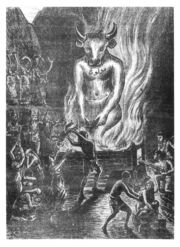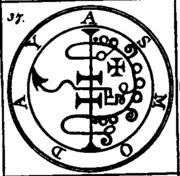Definition
Demonology which involves exegesis, is an orthodox branch of theology relating to superhuman beings who are not gods. It deals both with benevolent beings that have no circle of worshippers or so limited a circle as to be below the rank of gods, and with malevolent beings of all kinds. Demonology, though often referred to with negative connotation, was not always seen as evil or devilish as the term would have one believe.
The ascription of malevolence to the world of spirits is by no means universal. In West Africa the Mpongwe believe in local spirits, just as do the Inuit; but they are regarded as inoffensive in the main. Passers-by must make some trifling offering as they near the spirits' place of abode; but it is only occasionally that mischievous acts, such as the throwing down of a tree on a passer-by, are, in the view of the natives, perpetuated by the class of spirits known as Ombuiri.[14] So too, many of the spirits especially concerned with the operations of nature are conceived as neutral or even benevolent; the European peasant fears the corn-spirit only when he irritates him by trenching on his domain and taking his property by cutting the corn;[15] similarly, there is no reason why the more insignificant personages of the pantheon should be conceived as malevolent, and we find that the Petara of the Dyaks are far from indiscriminating and malignant, being viewed as invisible guardians of mankind.[16]
Nature
Types
It may be noted that the original sense of "demon," from the time of Homer onward, was a benevolent being;[4] but in English the name now holds connotations of malevolence. Demons, when they are regarded as spirits, may belong to either of the classes of spirits recognized by primitive animism;[5] that is to say, they may be human, or non-human, separable souls, or discarnate spirits which have never inhabited a body. A sharp distinction is often drawn between these two classes, notably by the Melanesians, the West Africans and others; the Arab djinn, for example, are not reducible to modified human souls; at the same time these classes are frequently conceived as producing identical results, e.g. diseases.[4][3]
Under the head of demons are classified only such spirits as are believed to enter into relations with the human race; the term therefore includes:
- angels in the Judeo-Christian tradition that fell from grace,[4]
- human souls regarded as genii or familiars,[6]
- such as receive a cult (e.g., ancestor worship),[4]
- ghosts or other malevolent revenants.[7]
Excluded are souls conceived as inhabiting another world. But just as gods are not necessarily spiritual, demons may also be regarded as corporeal; vampires for example are sometimes described as human heads with appended entrails, which issue from the tomb to attack the living during the night watches. The so-called Spectre Huntsman of the Malay Peninsula is said to be a man who scours the firmament with his dogs, vainly seeking for what he could not find on earth - a buck mouse-deer pregnant with male offspring; but he seems to be a living man; there is no statement that he ever died, nor yet that he is a spirit. The incubi and Succubi of the Middle Ages are sometimes regarded as spiritual beings; but they were held to give proof of their bodily existence, such as offspring (though often deformed).[8] Belief in demons goes back many millennia.
Number
According to some societies, all the affairs of life are supposed to be under the control of spirits, each ruling a certain "element" or even object, and themselves in subjection to a greater spirit. The Zoroastrian faith teaches that there are 3,333 Demons, some with specific dark responsibilities such as war, starvation, sickness, etc.
The Inuit are said to believe in spirits of the sea, earth and sky, the winds, the clouds and everything in nature [9]. Every cove of the seashore, every point, every island and prominent rock has its guardian spirit. All are potentially of the malignant type, to be propitiated by an appeal to knowledge of the supernatural.[10] In Korea, countless demons inhabit the natural world; they fill household objects and are present in all locations. By the thousands they accompany travelers, seeking them out from their places in the elements.[11]
In ancient Babylon, demonology had an influence on even the most mundane elements of life, from petty annoyances to the emotions of love and hatred. The numerous demonic spirits were given charge over various parts of the human body, one for the head, one for the neck, and so on. In present-day Egypt, the ubiquitous jinn are believed to be so densely distributed that acts such as pouring water unto the ground are accompanied by seeking the permission of a potentially dampened spirit.[11]
Greek philosophers such as Porphyry, who claimed influence from Platonism,[12] and the fathers of the Christian Church, held that the world was pervaded with spirits,[11] the latter of whom advanced the belief that demons received the worship directed at pagan gods.[13]
History/Beliefs
Zoroastrian demonology
In the Zoroastrian tradition, Ahura Mazda, as the force of good Spenta Mainyu, will eventually be victorious in a cosmic battle with an evil force known as Angra Mainyu or Ahriman.[17]
Jewish demonology
While historical Judaism never "officially" recognized a rigid set of doctrines about demons,[18] many scholars believe that its post-exilic concepts of eschatology, angelology, and demonology were influenced by Zoroastrianism.[19][20] Some, however, believe that these concepts were received as part of the Kabbalistic tradition[21] passed down from Adam, Noah, and the Hebrew patriarchs.[22] See Sefer Yetzirah.
The Talmud declares that there are 7,405,926 demons, divided in 72 companies. Indeed, some commentators hold that Satan was a prosecutor for God in early Judaism, and a somewhat minor angel at that.[23] While most people believe that Lucifer and Satan are different names for the same being, not all scholars subscribe to this view.[24]
There is more than one instance where demons are said to have come to be, as seen by the sins of the Watchers and the Grigori, of Lilith leaving Adam, of demons such as vampires, the demon-locusts from the Book of Revelation, impure spirits in Jewish folklore such as the dybbuk and of wicked humans that have become demons as well.[25][26]
Christian demonology
Christian demonology is the study of demons from a Christian point of view. It is primarily based on the Bible (Old Testament and New Testament), the exegesis of these scriptures, the scriptures of early Christian philosophers and hermits, tradition, and legends incorporated from other beliefs.
Since early Christianity, demonology has evolved from a simple acceptance of demons to a complex study that has grown from the original ideas taken from Jewish demonology and Christian scriptures. Christian demonology is mainly studied within the Roman Catholic Church, although some other Christian churches do not deny the existence of demons. According both to Christian theology and Christian demonology, all evil in the world is caused by demons with God's permission, as their mission serving God; for example in the narratives of the Book of Job and the Temptation of Christ.
Origin
According to the Book of Revelation (Rev 12:9), demons are the angels that fell from heaven with Satan when he chose to rebel against God. In the 15th century, it was estimated that 133,306,668 angels fell from the Heavens in a total of 9 days according to the Bishop of Tusculum (c. 1273), and this was reaffirmed by Alphonso de Spina (c. 1460).
Justin Martyr, a Christian who lived circa 150 AD, believed (based on Gen 6:2-4) that demons were the offspring of angels and men. The Greeks viewed demons as the spirits of wicked dead men (Heb 9:27).
In John 8:44 Jesus calls the Devil "the first homicide" ("he was a murderer from the beginning" in the King James Version), perhaps referring to the murdering of Abel by Cain, a liar, and father of all lies.
Nature
According to Christian tradition, demons can be angels, are spiritual, immutable and eternal. Demons are not omniscient, but each one has a specific knowledge (sometimes on only one subject, sometimes on more than one). Their power is limited to that which God allows, so they are not omnipotent. No reference has been made about omnipresence, so it is as yet unclear if they can be in different places at the same time, but according to the tradition of the medieval witches' Sabbath, two conclusions can be reached: either Devil can be in different places at the same time, or he sends an emissary in his name, but it seems that the only 'omni' thing they are is malevolent; it is deducible from some passages of the Bible that they are not omnipresent.
Behavior
Christian demonology states that the mission of the demons is to induce humans to sin, often by testing their faith in God. Christian tradition holds that temptations come from three sources: the world, the flesh, and the devil. Demons have also the duty of punishing the souls of those people that died out of God's grace (in sin), by torturing them in Hell.
It is also believed that demons torment people during their life, like the case of Job or through possession, causing disgraces and diseases, or simply showing themselves before persons to frighten them, or by provoking visions that could induce people to sin or to be afraid. (Luke] 13:16; Matthew 17:15-16)
Demons are also believed to try to make people abandon the faith, commit heresy or apostasy, remain or turn themselves Pagan or venerate "idols" (the Christian term for cult images), and gain the highest number of adversaries of God. (Ephesians 6:12).
Powers
Demonic supernatural powers are believed to include Fabrication, Psychokinesis, Pyrokinesis, Levitation, Cryokinesis, Biokinesis, Divination, Demonic possession, seducing spirits, ESP, telepathy, mind probing, witchcraft, curses and hexes, as well as binding, magnification, and making contracts, weather control, animal control, and provacation. Demons use variants and combinations of these powers to harass, demoralize, confuse, and disorient the victim, or the willing subject of demonic interest. Many of these attacks can be limited by God for duration, effect or scope of these Demonic attacks. A fictional example of the above is featured in the movie The Exorcist.
Demons are believed to have the power to physically or mentally hurt people, but only within the boundaries of what God will allow. Demons can destroy anything material on the earth; these supernatural powers are always inferior to the power of God. God may use His will to cancel or destroy any effect the demon chooses to invoke. Demons, however, are granted permission to test, bring about trials, and to tempt people through the use of their destructive powers, to make people prove their faith, sometimes as a means to carry out the will of the Lord. Often Demons are said to creating negative emotions, wrecking havoc, ensuing chaos, and disrupting peace.
Appearance
Referring to their appearance, demons can take any desired appearance, even that of an "angel of light" (2 Corinthians 11:14). Nevertheless, they were generally described as ugly and monstrous beings by Christian demonologists. Many of these descriptions have inspired famous painters like Luca Signorelli, Hieronymus Bosch, Francisco Goya, the artist that made the drawings for the Dictionnaire Infernal, and others.
Incubi and Succubi are described as being beautiful in order to accomplish their mission of seduction.
However, according to Nicholas Remy, the figure of the demons is imperfect, which he deduced from the descriptions given by those accused persons interrogated during the witch trials; he wrote:
"...that proves how marvellous God's love is, even for the most miserable human beings, being that demons can never take a human figure in a perfect form, and so the most stupid people are able to discover them".
The idea that demons have horns seems to have been taken from the Book of Revelation 13:1 (here it seems that John the Evangelist was inspired by Leviathan) and 13:11. The book of Revelation seems to have also inspired some absurd depictions of demons (Revelation 13:1-2). This idea can also been associated with the depiction of certain ancient gods like Baal, Moloch, the shedu, etc, which were portrayed as bulls, as men with the head of a bull, or wearing bull horns as a crown.
While there is no conclusive theory about why the Devil appears with a tail, the trident attributed to him as his "sceptre" may have been inspired by early contact between Christians and Hindus. In Hinduism, the trident is Shiva's weapon.
Occult demonology
The grimoires of occult magic are the tomes that contain the lore of this version of demonology, containing instructions on how to summon them and bend them to the conjuror's will, yet not all occultists modern and ancient necessarily evoked demons. Practitioners of Ceremonial magic sometimes attempt to constrain and command demons to do their bidding, using methods such as the Goetia and The Book of Abramelin. The demons are often those mentioned in Christian demonology. These practitioners do not necessarily worship demons, but seek to deploy them to obtain their goals.
Other followers of the occult do worship demons, and some refer to their religion as "demonolatry."[27]. Demonolators consider methods such as the Goetia very disrespectful towards the demons, and possibly dangerous for the operator. They instead use forms of prayer, magick and ritual which petition the demons, asking for their aid rather than commanding them.
Demonolators are not identical to practitioners of Theistic Satanism. They worship other demons (such as Belial and Leviathan) either alongside, or instead of Satan. [28] Some demonolators say that their form of demonolatry is a tradition, often familial, that is not related to the modern religious and philosophical movements collectively referred to as Satanism.[29]
Not all of the occultists who claim to worship demons are demonolators, just as not all Christians are of one exclusive denomination.
Islamic demonology
In Islam, the devil Iblis (Satan and/or Lucifer in Christianity) was not an angel, but of a different kind, the jinn. (Humans are created from earth, Angels from light, and jinn from fire). The jinn though, are not necessarily evil; they could be good doers or sinners just like humans. Since the jinn and humans are the only kinds of creation who have the will to choose, the followers of Iblis could be jinn or human. The angels, on the other hand, are sinless and only obey the will of God.[30]
In the Qur'an, when God ordered those witnessing the creation of Adam to kneel before him (before Adam), Iblis refused to do so and was therefore damned for refusal to obey God's will.[31]
Demonology in Buddhism and Hinduism
Some branches of Buddhism affirm the existence of Hells[32] peopled by demons who torment sinners and tempt mortals to sin, or who seek to thwart their enlightenment, with a demon named Mara as chief tempter.[33] Most of these "demons" are considered to be representations of mental obstructions. [34] Hinduism contains traditions of combats between its gods and various adversaries, such as the combat of Indra and the asura Vritra.[35]


